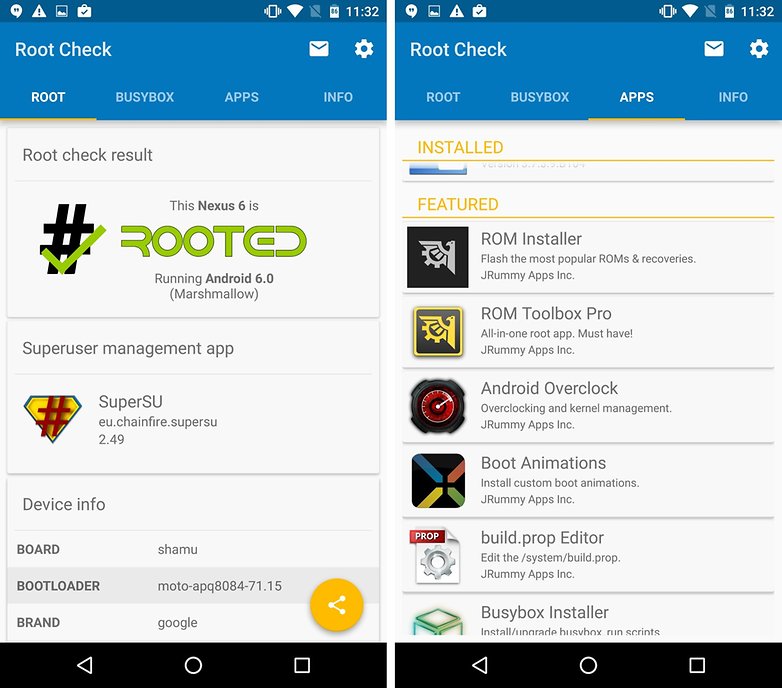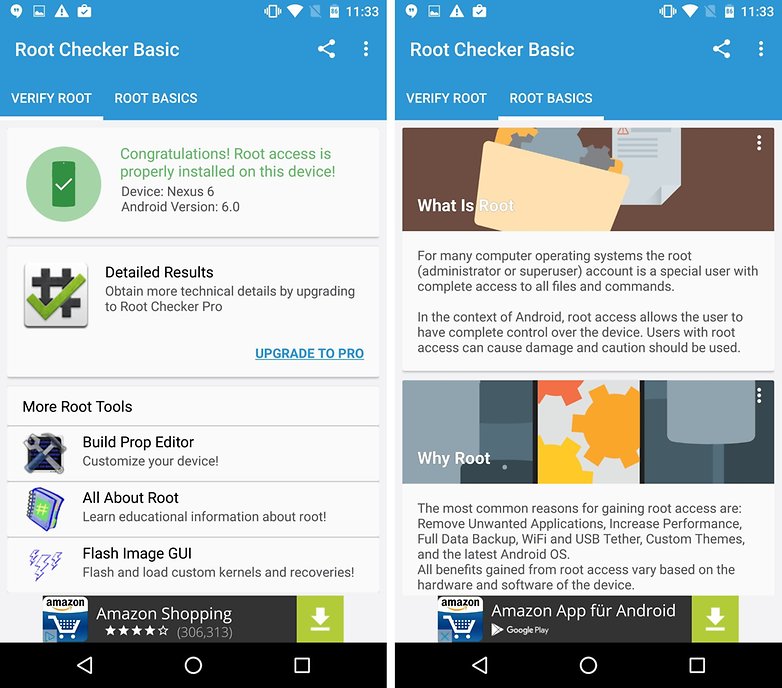Contents
If you root your Android smartphone, you unlock new functions of the smartphone. Learn all the advantages and disadvantages of root here. We’ll also show you which tools are the easiest to root your Android smartphone with.
What does root mean?
The term root comes from the Linux world. The rooting process in Android allows the user to obtain super user rights and full access to the file system of his device. This enables profound adjustments and changes to the software. But it also poses a great danger to inexperienced users because important system files can be deleted. This is also one of the reasons why Android does not give you root privileges by default and why you shouldn’t handle them lightly.
The root access is often carried out by a script, which is installed in the download mode of Android and which is then carried out automatically. This script often exploits a security vulnerability in the operating system core and carries out a so-called privilege escalation . This rise in rights turns you from a user to a super user who can enjoy the root privileges explained above . The SuperSU app installed ensures that you retain control over when an app uses these root rights.
Do I lose my guarantee or warranty by rooting?
Many users worry that they will lose their guarantee if they root their smartphone. That is why we asked the different smartphone manufacturers very specifically to compare this concern and the myths surrounding rooting with facts once and for all. HTC specifically writes:
“There are basically legal provisions on this subject based on EU Directive 1999/44 / EC. HTC respects and generally complies with applicable EU law. This also applies to the area of modified software for HTC products.
If a user’s HTC device has a root, this is not synonymous with the expiration of their existing warranty claim. This claim does not apply, however, if the device has a defect that is demonstrably attributable to the changed software environment or the root. “
LG sums up briefly and says that the guarantee expires when rooting. At Sony we are less hard, because there is:
“If such a modification is recognized in the workshop, we look at these cases individually. If the defect is not related to the root and a repair is possible, we make a gracious decision for the customer.”
So you can at least hope for a rescue at Sony.
Samsung is also tough and writes:
“Since rooting usually does not permit modifications to the product, the warranty granted by Samsung does not apply in this case. […] Regardless of this, the statutory provisions apply to the warranty rights of the buyer against the seller.”
The Free Software Foundation Europe (FSFE) has dealt with the root issue and came to the conclusion after a detailed examination that, according to EU Directive 1999/44 / CE , warranty claims continue to apply even after rooting and installing custom ROMs can be claimed two years after purchase. If your smartphone or tablet has a defect, the seller from whom you bought the device must not refuse the guarantee. The seller is even obliged to provide evidence: he has to prove that the damage has occurred due to the software change. However, he only has the burden of proof in the first 6 months after purchase. After that you have bad cards anyway as a buyer.
Example 1: You root your smartphone and install the popular custom ROM LineageOS. Suddenly, the button for switching your smartphone on and off is released due to a material defect. Here the warranty is very clear. But the same applies here: after the first six months, you are under the obligation to provide evidence that the material defect on the button was present right from the start.
Example 2: You root your smartphone, install LineageOS and also a new kernel that overclocked your CPU and should provide more performance. The smartphone processor does not like this at all, it heats up too much and literally smokes. The warranty does not apply here because the damage was clearly caused by rooting.Opinion by Eric Ferrari-HerrmannThe fear of the expired guarantee is exaggerated.Do you agree?50501015 participants
Preparation: How can I root my Android phone?
Depending on the smartphone manufacturer, rooting Android is more or less complex and risky. Fortunately, the resourceful developers of the various Android root methods have now made the tools quite user-friendly. Nevertheless, you should always inform yourself in the special forums for your smartphone, which root method is suitable for your device and which special precautions you may have to take.
Rooting Android is not rocket science, but of course there is a risk involved. Google is also working with every new version of Android to make the rooting process more difficult. In almost all cases, you need custom recovery to be able to execute the necessary commands for root access. TWRP is the custom recovery of choice, so we’ll install it first . After that, the real root process is on .
How do I install the TWRP custom recovery?
TWRP is a custom recovery with a long tradition and supports a long list of smartphones and tablets. Because the installation process differs a bit for every smartphone, you should take a look at the official website. There are full instructions for many popular smartphones. For the first installation you always need the ADB tools on your PC .
Can’t find your smartphone in this list? No problem. There are mostly unofficial versions of TWRP, but you can only find them in developer forums. Have a look at our forum for your device, because there you will definitely find help to discover the right TWRP version for your smartphone. You will also find what you are looking for in the forum of the XDA Developers . The unofficial TWRP versions are always well documented and provided with installation instructions.
Root with Magisk: The best root method explained
The easiest and fastest way to get root rights on modern smartphones is via the Magisk tool.
What makes Magisk so special? Magisk is much more than a method of rooting Android smartphones. Magisk consists of several tools, which together add up to the diverse possibilities. The most important tool installs itself in the boot partition and therefore does not change the Android system. You also install the Magisk Manager app .

The Magisk Manager is the actual magic tool, because it allows you to install different modules and features. With the Magisk Manager you also keep the entire Magisk tool chain up to date.
We have compiled a complete overview of Magisk and its capabilities in our Magisk manual .
Magisk: The installation
Before installing, you should find out whether Magisk is compatible with your smartphone. Ask for it in the relevant forums at AndroidPIT or the XDA Developers. The installation of Magisk is simple, but requires an installed TWRP. First download the current versions of Magisk and Magisk Manger, preferably on the Github project page, and save the files on your smartphone in the internal memory.
- Boots in TWRP
- Flash Magisk (the zip file)
- Reboot your smartphone
Now you install the Magisk Manager as a normal app and open it. Now you can check whether Magisk is installed correctly. In Magisk Manager you can change the settings for root. Magisk also enables you to pass the Safetynet check.
Root devices from Samsung, LG or Sony
The exact procedure for rooting differs from smartphone to smartphone. XDA has a list of current procedures and informative descriptions for a large number of smartphones.
- XDA Developers : Overview of how to root smartphones
To root a Samsung smartphone, you should make sure that you use the instructions for the correct device version. In some cases you have to unlock the boot loader. The procedure for this is stored in the device-specific instructions.
Many conventional root methods are available, especially for older smartphones. For various reasons, these are no longer applicable to modern smartphones. Mostly because they exploit security gaps that have now been closed on the Android side. Check out the list of XDA developers to see if your older smartphone can be unlocked using SuperSU, CF-Autoroot or others.
Is my device rooted now? Is there a root check?
There are many apps in the Play Store that answer exactly this question. A root check is suitable to record the success of rooting or to find out whether your custom ROM has already integrated root or not.
The first app comes from JRummy Apps. The Root Check finds out free of charge whether your smartphone is rooted. If you have super user privileges, the root check also serves as a showcase for apps that make these rights usable.

The second app comes from the developer with the pseudonym Joeykrim. In addition to app recommendations and a freemium model, his root checker also uses banner advertising. In return, you will receive a glossary that provides you with the most important information about root in Android. Joeykrim is also known for its root quiz .

Is root still up to date?
Root is a thorn in Google’s side. Therefore, there are no longer many root methods for modern smartphones. Safetynet is a very special trap. Safetynet checks the integrity of the software in your smartphone and this can be compromised when accessing the root. Magisk is hiding quite well, but the good old SuperSU is not.
If an app requests a Safetynet check and this fails, apps refuse to start. Well-known culprits are, for example, Google Pay, but also Pokémon Go.
The added value of root is now also questionable. In view of increasingly powerful processors and more memory, tuning smartphones is hardly necessary anymore. Root allows a full backup (via Titanium) and access to detailed statistics.
